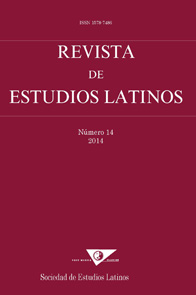Voluptas, Vitium and Virtus beside Hercules: from text to image
DOI:
https://doi.org/10.23808/rel.v14i0.87713Keywords:
Hercules, crossroads, Cicero, emblematics, uoluptas.Abstract
The objective of this paper is to study the most important versions of the story of Hercules at the crossroads in Greek and Latin literatures, the origin of different denominations of its female characters (Voluptas, Vitium y Virtus) and their iconography and the importance of Cicero’s translation. Also this study analyze the use of this legend in the emblematic literature, especially in Bocchi’s Symbolicarum quaestionum and Junius’s Emblemata.Downloads
References
ALLEN, D. C. (1944): «The rehabilitation of Epicurus and his theory of Pleasure in the Early Renaissance», Studies in Philology 41, 1-15.
ANTÓN, B. & ESPIGARES A. (2013): Adriano Junio. Emblemas (Estudio introductorio de B. Antón. Traducción, notas e índices de B. Antón y A. Espigares), Zaragoza, Libros Pórtico.
ASENCIO, E. (2004): «La littera Pythagorica. El simbolismo de la “Y” en la literatura y en el arte», Alfinge, 16, 95-114.
ASENCIO, E. (2005): La mitología clásica en la emblemática española. Tesis doctoral. Universidad de Córdoba. Departamento de Ciencias de la Antigüedad y de la Edad Media < http://helvia.uco.es/xmlui/handle/10396/241> [20/03/2014]
BERMEJO, V. (1996): «La exaltación de la virtud en la propaganda regia. Del Bivium Heraclida al Speculum Consacratum en el reinado de Felipe II», en López Poza S. (ed.), Literatura emblemática hispánica. Actas del I Simposio Internacional (A Coruña, 1994), A Coruña, Universidad, 311-327.
CAPELLI, G. M. (2002): El humanismo romance de Juan de Lucena. Estudios sobre el “De vita felici”, Barcelona, Centro para la Edición de los Clásicos Españoles.
DE RUYT, F. (1931): «L'idée du “Bivium” et le symbole pythagoricien de la lettre Y», Revue belge de philologie et d’histoire 10, 137-145 <http://www.persee.fr/web/revues/home/prescript/article/rbph_0035-0818_1931_num_10_1_1340 > [27/03/2014]. doi: 10.3406/rbph.1931.1340.
ESPIGARES, A. (2011): «Ciceronianismo en los primeros libros de emblemas: la oposición puer / senex en los Emblemata (Amberes,1565) de Adriano Junio», en Zafra, R. & Azanza, J.J. (eds.), Emblemática trascendente. Hermenéutica de la imagen, iconología del texto, Pamplona, Universidad de Navarra, 287-300.
ESPIGARES, A. (2013): «Cuestiones religiosas en los Emblemata (Amberes, 1565) de Adrianio Junio», IMAGO. Revista de Emblemática y Cultura Visual 5, 19-33.
GARIN, E. (1992): La cultura filosofica del rinascimento italiano, Firenze, Sansoni Ed.
HENKEL, A. & SCHÖNE, A. (1996): Emblemata. Handbuch zur Sinnbildkunst Des XVI. Und XVII. Jahrhunderts, Stuttgart, Metzler.
KOERNER, J. L. (1993): «Homo Interpres in Bivio. Cranach and Luther», en The Moment of Self-Portraiture in German Renaissance Art, University of Chicago Press, 363-410.
LÓPEZ POZA, S. (2013): «Moral neoestoica alegorizada en El Criticón de Gracián», Mélanges de la Casa de Velázquez, Nouvelle série 43/2, 153-173.
LÓPEZ TORRIJOS, R. (1985): La mitología en la pintura española del Siglo de Oro, Madrid, Cátedra.
LÓPEZ TORRIJOS, R. (1989): «La alegoría de la encrucijada en el arte español del siglo XVI», en Los caminos y el arte, Actas del VI Congreso Español de Historia del Arte, vol. III , Santiago de Compostela, Universidad, 127-136.
MARTÍNEZ MANZANO, T. (2010): «El Pinciano y san Basilio, a propósito de la versión de Bruni de la Epistula ad adulescentes», Exemplaria Classica 14, 249-262. <http://rabida.uhu.es/dspace/bitstream/handle/10272/5632/El_Pinciano_y_San_Basilio.pdf?sequence=2> [12/03/2014]
MICHEL, A. (1974): «Epicurisme et christianisme au temps de la Renaissance: Quelques aspects de l’influence cicéronienne», Revue des Études Latines 52, 356-383.
MICHEL, A. (1992) : «Cicéron et la langue philosophique: problèmes d’éthique et d’esthétique», en La langue latine, langue de la philosophie : actes du colloque organisé par l'École française de Rome avec le concours de l'Université de Rome "La Sapienza" (Rome, 17-19 mai 1990), Paris, École Française de Rome, 77-89.
MOMMSEN, TH. (1953): «Petrarch and the Story of the Choice of Hercules», Journal of the Warburg and Courtauld Institutes 16, 178-192.
PANOFSKY, E. (1930): Hercules am Scheideweg und andere antike Bildstoffe in der neueren Kunst, Berlin-Leipzig, Teubner (reimp. 1997).
PONCELET, R. (1957) : Cicéron traducteur de Platon. L’expression de la pensée complexe en latin classique, Paris, De Boccard.
POWELL, J. (1999): «Cicero’s Translations from Greek», en Powell, J.(ed.), Cicero the Philosopher. Twelve papers Edited and Introduced by J.G.F. Powell, Oxford, 273-300.
TIETZE-CONRAT, E. (1951): «Notes on “Hercules on the Crossroad”», Journal of the Warburg and Courtauld Institutes 14, 305-309.
WAITES, M.C. (1912): «Some Features of the Allegorical Debate in Greek Literature», Harvard Studies in Classical Philology 23, 1-46 <http://www.jstor.org/stable/310446> [18/03/2014]
Downloads
Published
How to Cite
Issue
Section
License
Copyright (c) 2014 Revista de Estudios Latinos

This work is licensed under a Creative Commons Attribution-NonCommercial-NoDerivatives 4.0 International License.
The originals published in the printed and electronic editions of this journal are the property of the Revista de Estudios Latinos and can be circulated as long as the original source and authorship is made clear in any reproduction, full or partial, of the same, and as long as this is not done for commercial purposes.








